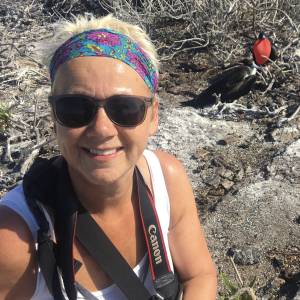Waitangi Treaty Grounds
We immediately fall in love with Russell, even in the damp mists of our first evening. New Zealand’s first capital (well actually that was nearby Okarito and only for about six months) and once known as ‘Hell hole of the pacific’ - full of whalers, STDs and general misrule - Russell is now one of the most charming backwaters we’ve visited. Accessible only by ferries or long land detours, there’s no traffic passing through, and it’s full of gorgeous colonial style clapperboard buildings.
Arcadia Lodge, our Bed and Breakfast, is just wonderful. Housed high above the town, the century old house is built on whale bones (a huge vertebra is on display) has stunning views, a glorious garden and magnificent hospitality supplied by hosts Greg and Peter. Breakfast on the veranda is glorious!
This is not only an area of great beauty, but also one steeped in history, and just over the water lie the Treaty Grounds at Waitangi - generally seen as the birthplace of the nation. And it is here where we focus our energies today.
There’s an early detour to The Stone Store at Kirikiri - a beautiful old building in a delightful setting which dates from 1836. Still trading - though obviously now in the souvenir business - this was a meeting place between Māori and missionaries; sadly time prevents us touring nearby Kemp House. We’re quickly realising there’s so much history in this area, but so little time …
It’s then down to the serious business of exploring Waitangi and the Treaty Grounds - and at this point I must apologies to all my New Zealand blipper friends for my inaccuracies or misunderstandings (in fact, I’ve been meaning to say this since we started our travels here, as it’s so easy to not fully grasp the essence of a place when you’re just passing through). It’s beautifully situated amongst endemic planting intended to recreate the 1840s when the treaty was signed. To be honest, we spend much of our time here frustrated as we just can’t grasp what went on here and it’s significance to modern New Zealand - and our guide is of limited help, sounding as if he’d rather be anywhere else rather than here. Yes, we know it’s visited by every dignitary imaginable, all of whom it seems plant trees, but we want to know the details of what happened here. It’s not really until we’ve visited the excellent museum - ironically and foolishly at the end of our visit - that things really start to click into place. It’s taken time for us to even start to appreciate the history, roles and rights of the Maori people in New Zealand - and of course, it seems that it’s only in the last 50 years or so that this has become a major focus here in New Zealand too with the Waitangi Tribunal set up to correct the loss of Māori rights, culture etc over the previous century.
While the Treaty of Waitangi was an agreement between the Crown and the Maori, it also seems to be the founding principle of New Zealand independence and governance, with its underlying acceptance that the rights of both Māori the Pakeha (non-Maori) are protected - something that seemed to be forgotten as the Pakeha settlers gained more and more land just as in any country colonised by European powers. What we’ve seen and heard during our short time in the country - including our cruise stops - certainly suggests that the Tribunal has done much to redress the balance. But it’s a very complicated issue as even my limited reading around the subject reveals.
Our evening sees us return to the sea front in Russell where we staggered to after yesterday’s long drive. Our meal at John’s was so enjoyable, we decided to return tonight and it’s every bit as good. Great food, excellent service, a lively atmosphere and a window table overlooking the bay - this time with sunshine and a watery sunset rather than mist of yesterday. Magic!
My main shows the carved figure (nose and forehead suffering from repeated ‘hongi’ greetings from visitors!) at the front of the largest ceremonial canoe in the world - the 35-metre-long waka named Ngatokimatawhaorua. It is launched every Waitangi Day requiring some 70 paddlers.
In extras is a collage including another view of the wake, the Treaty House where the treaty was signed in 1840, and the Maori meeting house - Te Whare Runanga dating from a century later. There would also be a shot of The Stone Store - if we had better internet. It just refuses to upload!

Comments
Sign in or get an account to comment.


